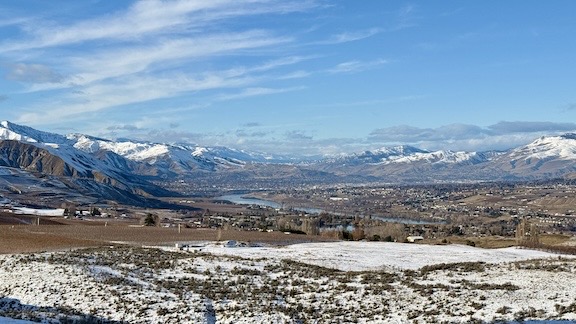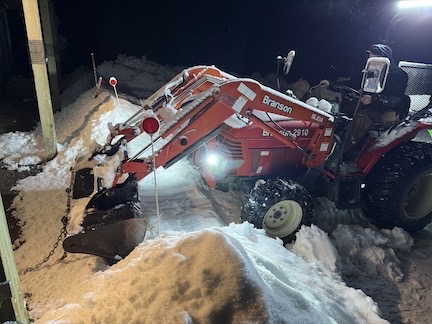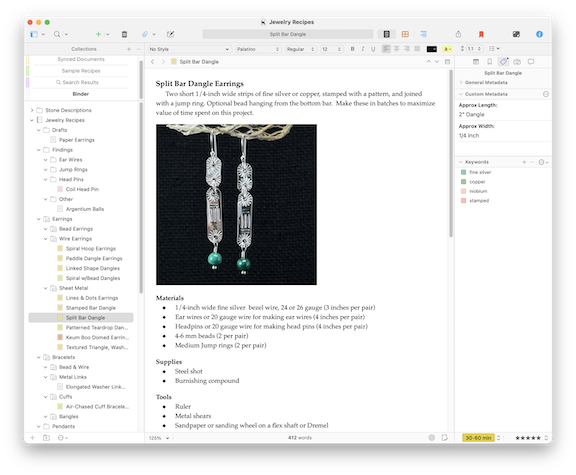I look back at the year that just ended and forward into the year just beginning.
As I get older, I’m spending a lot more time thinking about the past and the future. I thought I’d take a moment to jot down some of my thoughts as we change calendars and start a new year.
Goodbye 2024
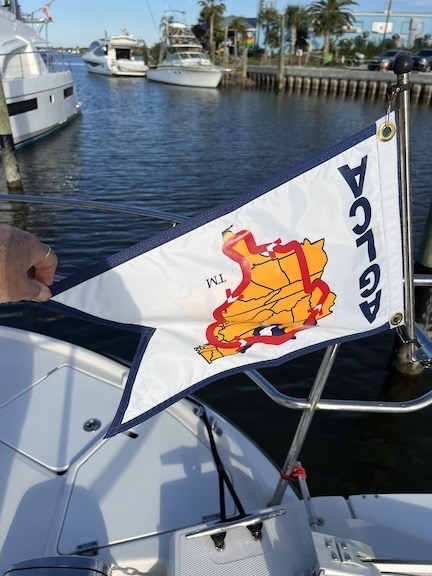
I’m not a member of this organization, which seems to exist primarily to separate Great Loop cruisers and wannabes from their money. I got the flag for free and flew it to identify myself as a Looper to others; not many realized I hung it upside down.
I’ve been thinking a bit about the year that just ended — as most of us probably do around New Year’s Day. It was my first full year of “retirement” (whatever that is in my life), a year when I completed a handful of personal achievements to move me forward in my life.
The biggest of these was the completion of my Great Loop cruise, a non-event that occurred on August 12, 2024 in Chicago, IL when I cruised past the entrance to the Chicago River and into DuSable Harbor. It was the culmination of about 16 months of cruising, mostly solo, over the course of 22 months in the boat that members of my family (who I now realize never really knew me very well) claimed I’d never use.
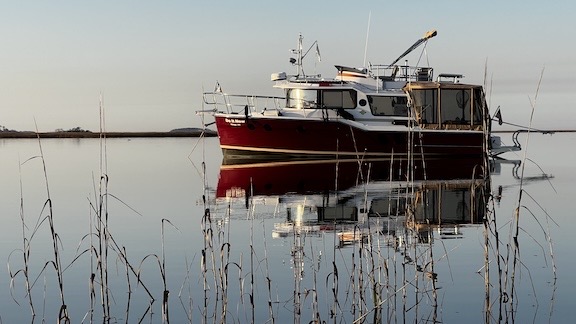
One of my favorite anchorages last winter was just off the ICW in Georgia.
In the 8,300+ nautical miles I traveled on all kinds of waterways — rivers, lakes (including three Great Lakes) , bays, gulfs, canals, the ICW, and the Atlantic Ocean — I really honed my skills as a mostly solo boat captain. That served me very well in late September, when those skills were recognized and I was offered a job as a powerboat instructor for single and twin engine boats up to 50 feet in length. I took two classes to get the additional certifications I needed (in addition to my USCG captain’s license, which I got in 2023). I start that work later this year.
(I could write a whole blog post about how my hobbies and interests have turned into paying work — and even careers — throughout my life, but I’ll save that for another day.)
I put my silversmithing work pretty much on hold during 2024, although I did get a few jewelry classes in at Gallery One. I also managed to sell some jewelry to a new wholesale account on Bald Head Island in North Carolina. (Be sure to check out the Silver Peddler for my work if you’re ever out there.)
I did start a new hobby — like I needed one — bookbinding. This combines my love of addiction to paper with my love of books and writing. I’m just starting to get the hang of it now. I find the stitching of text blocks to be strangely soothing and rewarding. I think a lot of my friends will be getting books as gifts in the months and maybe years to come.
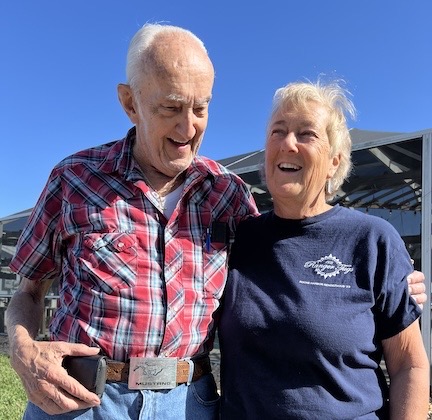
My stepmom took this photo of my dad and me at their house in Florida last winter. At the time, my dad was 84 and working full time at Home Depot.
I also reconnected with my dad after so many years of him just being a background figure in my life. This actually started in 2023, when I first cruised to his Florida home in my boat on my way north along the Great Loop route. I stopped there again twice in late 2023 and then again in early 2024. It was a pleasure to be with a family member who wasn’t judging me or trying to get me to do what they thought I should do. A family member who seemed genuinely proud of who I am and what I’ve achieved. Sadly, I lost my dad to a combination of illnesses in September. He was 85. I need to blog a bit about that, but I’m not quite ready.
Realizations
I realized a few things about my extensive traveling over the past two years.
First, even after spending more than half my time traveling, I still love to travel. There’s something very appealing to me about every day having the potential to be very different from the day before it. I love seeing new things and meeting new people. I love the challenge of plotting a course — whether it’s on a boat or in a car — and seeing where it takes me beyond just the expected geography. Of seeing how it helps me learn and grow as a person.
But, at the same time, I really do love my home and enjoy its comforts. It’s nice to have a washer, dryer, dishwasher, soaking tub, and unlimited water, electricity, and high speed Internet. I love the views and the privacy and the peace. I missed my garden and the chickens I had to give away. It’s easy to see why so many people would rather just stay home than explore beyond that, where things might not be as easy or as comfortable. But after just weeks at home starting in October, I was aching to get out again.

I admit it: near the end of my Great Loop cruise, I was a little bit homesick.
Other things I realized:
- I spend entirely too much time on social media. I’m only on Mastodon these days — an algorithm-free Twitter-like system with a much higher percentage of smart, socially conscious people than you’d find on Twitter, Facebook, or Instagram. That has fueled one of my two tiny resolutions: no browsing social media between 6 AM and 6 PM. I’m tired of so much of my time being sucked away. I want to be more productive.
- I am losing focus of the things that matter to me. Those things are mostly my writing and other creative endeavors. I blame time wasted on social media for that. But I also blame myself for being so easily distracted. It’s another thing I need to work on in this new year.
- I’m getting old. I’ve actually been realizing this bit by bit over time, but now it seems to be on my mind more. Feeling out of shape, losing the strength I had just 10 years ago when I was building my home. It’s harder to do some of the things I used to do with ease. Part of that is letting myself get heavier again; so much energy is wasted just moving my body around! Another part is simply not being as physically active as I was. That’s another thing I need to address in the new year. But another part is the fact that my friends are starting to die off or get seriously ill. I’m not the only one aging. Time is short for all of us.
Looking Forward to 2025
The completion of my Great Loop cruise — which had been a personal goal for a few years — left me without a goal or direction. I have some ideas of what I want to do in the next stage of my life and have taken a few steps toward those things. Using my boat captain credentials to teach people how to drive boats is just one part of that. Taking a break from long-term cruising and putting my boat into a charter fleet so it can earn me some money while being ready for me to cruise when it’s not booked is another. And yes, I even started a new business to manage both of those boat-related endeavors.
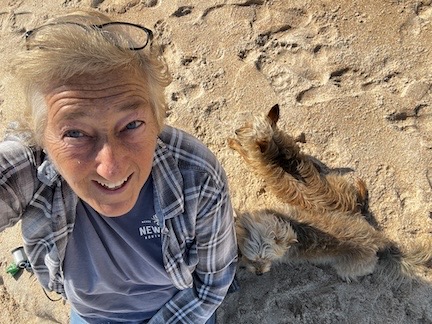
Here’s a rare selfie of me sitting on the sand with my pups at Marineland’s beach.
But I think I’d also like to return to the northeast to do some cruising in New York and Canada. I just don’t want to do it in my current boat. I want to upsize. And I want to take others along to see what it’s like. To share the joy I feel when I cruise across a smooth body of water on a perfect day, or pull into a marina at a brand new destination, or drop anchor near a deserted beach.
And I think I’d like to spend my winters in Arizona, where I can look out the window and see desert hillsides studded with saguaro cacti, mesquite, and palo verde. Where I can feel the sun on my skin in December and January. That means selling my house — I know the folly of owning more than one home — which means downsizing. It also means finding the place that’s right for me. I think I have just one more move left in me so I need to make it count. And I know how hard it’s going to be to find a place that comes close to the near perfection of what I have now, someplace I can move to without regrets.
In the meantime, I need to finish a few projects I started that are related to the Great Loop trip. The biggest is the blog that has too many gaps in the account of the trip. That blog will eventually become a book — my first in nearly 10 years. That’s the kind of project I’d like to get done before the boating season starts again.

